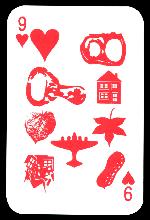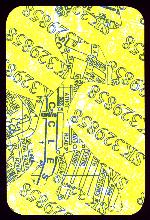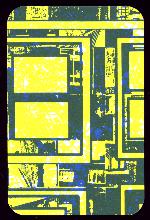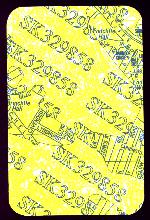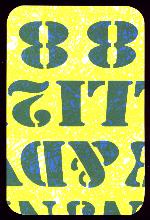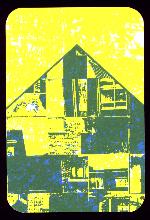This deck of cards refers to the events surrounding the crash of an American bomber in a Sheffield Park. They are also a meditation on the site today and the way in which the events of 50 years ago live on in the collective memory. I cannot now visit the site and see it as just a piece of woodland. The knowledge of what happened there is inextricably linked with the way in which I perceive the site. The imagery on the cards comes both from history and the contemporary, from the crash and the surrounding area. Walking through the park today many natural and man-made items are found. The aluminium ringpull from drinks cans is perhaps the commonest man-made object found and this contemporary twisted metal became for me a sort of metaphor for the twisted metal which would have been present 50 years ago. The ringpull is a recurring theme in the cards. The Eight of Clubs

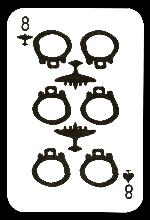 shows examples found in Endcliffe
Park, while other cards, for example the Eight of Spades
show a stereotyped version. I speculated that maybe the
metal from the plane, through various stages of recycling
had once more come to be among the trees in Endcliffe Wood
and this notion is referred to on the Jack of Clubs and
Seven of Spades.
shows examples found in Endcliffe
Park, while other cards, for example the Eight of Spades
show a stereotyped version. I speculated that maybe the
metal from the plane, through various stages of recycling
had once more come to be among the trees in Endcliffe Wood
and this notion is referred to on the Jack of Clubs and
Seven of Spades. 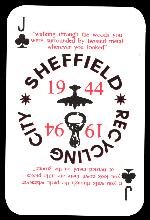
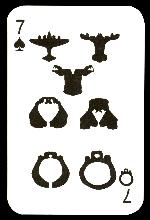 The idea of transformation and
metamorphosis also appears in the Ten of Clubs, Seven of
Hearts, Eight of Hearts and the Jokers.
The idea of transformation and
metamorphosis also appears in the Ten of Clubs, Seven of
Hearts, Eight of Hearts and the Jokers.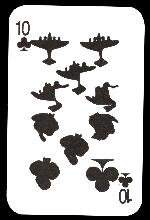
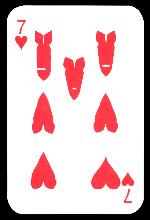 Whilst metal
ringpulls are the commonest man-made object in the park,
leaves are the commonest natural object and feature in
various forms in a number of the cards. The neighbourhood
of the crash, then as now, is a residential area. The
stylised 'safe' suburban house image is a reminder that the
plane narrowly avoided these houses. The bombed version of
this archetypal house is a reminder that the actual purpose
of the bomber was destroy property. In contrast to the
pictographic representation of the houses, actual
photographs or parts of photographs feature on the King of
Diamonds and Queen of Hearts
Whilst metal
ringpulls are the commonest man-made object in the park,
leaves are the commonest natural object and feature in
various forms in a number of the cards. The neighbourhood
of the crash, then as now, is a residential area. The
stylised 'safe' suburban house image is a reminder that the
plane narrowly avoided these houses. The bombed version of
this archetypal house is a reminder that the actual purpose
of the bomber was destroy property. In contrast to the
pictographic representation of the houses, actual
photographs or parts of photographs feature on the King of
Diamonds and Queen of Hearts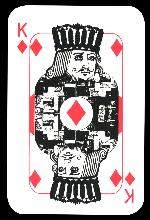
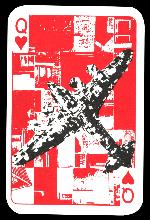 . Contemporary
newspaper stories are quoted on the Jack of Diamonds and
the Jack of Spades
. Contemporary
newspaper stories are quoted on the Jack of Diamonds and
the Jack of Spades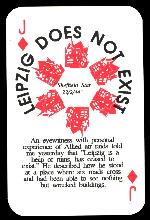
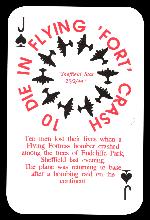 . The pilot was posthumously awarded
the Distinguished Flying Cross and the Jack of Hearts
carries an extract from his citation.
. The pilot was posthumously awarded
the Distinguished Flying Cross and the Jack of Hearts
carries an extract from his citation.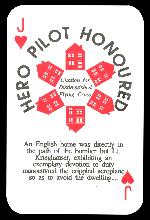 The Two of Spades shows the rooftops over
which the plane flew and the medal that the pilot received
for avoiding them. The Two of Diamonds and the Two of
Hearts show maps of the start and finish respectively of
the crews' last mission.
The Two of Spades shows the rooftops over
which the plane flew and the medal that the pilot received
for avoiding them. The Two of Diamonds and the Two of
Hearts show maps of the start and finish respectively of
the crews' last mission. 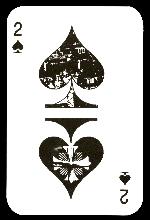
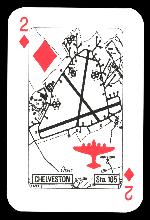
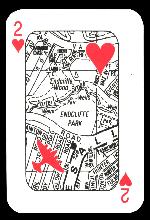 On that same day 38 Flying Fortresses
were lost, this is recorded on the Nine of Diamonds. Each
plane had a crew of ten, the names of the crew of the Mi
Amigo are shown on the Ten of Spades, which takes the form
of a Royal Observer Corp. silhouette chart. The Ten of
Hearts includes tiny photographs of the ten airmen.
On that same day 38 Flying Fortresses
were lost, this is recorded on the Nine of Diamonds. Each
plane had a crew of ten, the names of the crew of the Mi
Amigo are shown on the Ten of Spades, which takes the form
of a Royal Observer Corp. silhouette chart. The Ten of
Hearts includes tiny photographs of the ten airmen.
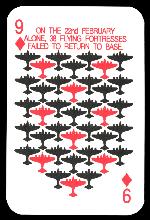
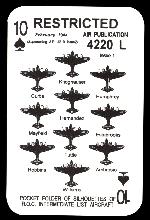
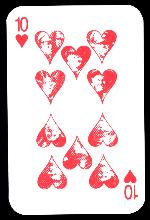 Single photos
of the crew also appear on the Six of Clubs, Four of Clubs,
Three of Clubs, Six of Spades, Four of Spades and Six of
Diamonds.
Single photos
of the crew also appear on the Six of Clubs, Four of Clubs,
Three of Clubs, Six of Spades, Four of Spades and Six of
Diamonds. 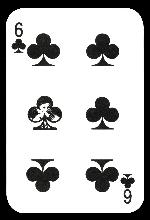
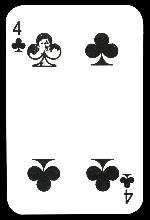
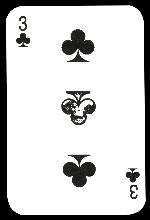
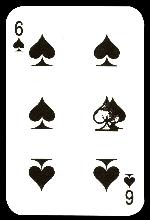
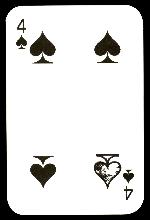
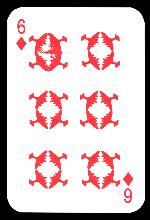
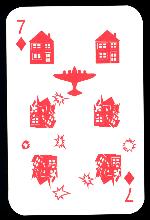 Maps play a vital role in any journey but in
a bombing campaign can also take on the function of death
warrant to those on the ground in the target area. I also
find maps interesting for their aesthetic appeal. The Queen
of Spades and the Queen of Diamonds include maps of
Sheffield and Germany respectively. The map reference for
the crash site, SK329858 was the title of a body of work
shown at the Mappin Art Gallery, Sheffield at the time of
the 50th anniversary. This map reference appears on the Ten
of Diamonds and the Ace of Spades. Aerial photography was
an important part of a bombing campaign. Automatic cameras
were mounted on the aeroplanes in order to record the
results of the bombardment. The images on the Ace of Clubs
and the Queen of Spades could be such photographs.
Maps play a vital role in any journey but in
a bombing campaign can also take on the function of death
warrant to those on the ground in the target area. I also
find maps interesting for their aesthetic appeal. The Queen
of Spades and the Queen of Diamonds include maps of
Sheffield and Germany respectively. The map reference for
the crash site, SK329858 was the title of a body of work
shown at the Mappin Art Gallery, Sheffield at the time of
the 50th anniversary. This map reference appears on the Ten
of Diamonds and the Ace of Spades. Aerial photography was
an important part of a bombing campaign. Automatic cameras
were mounted on the aeroplanes in order to record the
results of the bombardment. The images on the Ace of Clubs
and the Queen of Spades could be such photographs.

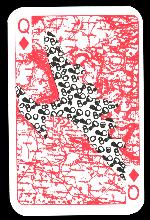
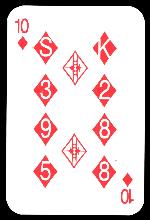
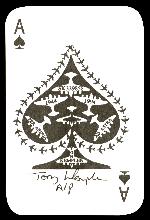
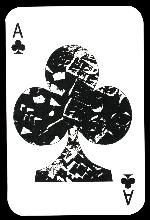 Unlike a
conventional pack of cards in which the backs are all
identical, this pack can be arranged into six groups of
nine cards which each form a simple jigsaw pattern
recalling the overall theme of the pack. The list of names
is based on the real names of the crew but becomes
increasingly distorted, an echo of the way in which
memories may become distorted with time. Finally the peanut
on the Nine of Hearts refers to the crews' mascot, a small
dog of that name.
Unlike a
conventional pack of cards in which the backs are all
identical, this pack can be arranged into six groups of
nine cards which each form a simple jigsaw pattern
recalling the overall theme of the pack. The list of names
is based on the real names of the crew but becomes
increasingly distorted, an echo of the way in which
memories may become distorted with time. Finally the peanut
on the Nine of Hearts refers to the crews' mascot, a small
dog of that name. 